Venice Amusement Pier
Revised April 6, 1998
Thornton Kinney announced, after the disastrous fire that completely destroyed the old Abbot Kinney Pier on December 20, 1920, that a new amusement pier would be rebuilt by summer and would be even better. However, despite the fact that the city couldn't afford to lose a season without its chief source of income, financing proved difficult. Two separate bond issues offered by the Kinney heirs were required to finance the rebuilding which took place that spring.Prior and Church, in charge of the reconstruction of the pier, began removing the burned out ruins in early February. Rail-cars of lumber arrived several weeks later in time for workers to begin pile driving. By April 15th, the last of the pier pilings was in place and the decking extended two-thirds to the end. The rebuilt pier was 1200 feet long and 525 feet wide. It looked like they would make their May 28th target when their workers went on strike. Fortunately it was settled quickly.
The Kinney Company built an enormous new dance hall. Its oval shaped orchestra pit was placed in the center of a hardwood dance floor 180 feet wide by 210 feet deep. Balconies extended around the entire pavilion and its interior was decorated in a Spanish motif.
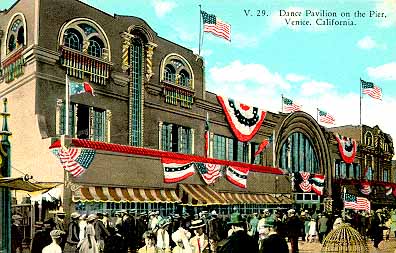
| The Venice Dance Hall on the pier was large enough for 800 couples to dance on its hardwood floor. - 1921 |
Many of the ride and concession operators on the old pier leased space on the new pier. The new Ship Cafe, now faced the water parallel to the shore, and was built to a larger scale. Ellis purchased another Dentzel Carousel and the owners of Over the Falls, Noah's Ark, the Great American Racing Derby and the Captive Aeroplanes planned to reopen with new and improved versions.
Prior and Church built a toboggan roller coaster next to their Big Dipper coaster. The ride called "Bobs" short for bob sleds was a 60 foot high coaster with tight banking dropped turns. His newly patented cars with a three point suspension and a shorter wheel base enabled the nine car trains to negotiate the sharper turns. The ride's first drop was in a darkened tunnel. Other new rides included a Dodge' em, Zig Zag and Whirl-igig.
The new pier opened on Memorial Day May 28, 1921. It wasn't the official opening (July 4th) but the Dance Hall and many of the new rides opened to a curious public. It was estimated that the new pier cost the Kinney family $3,000,000.
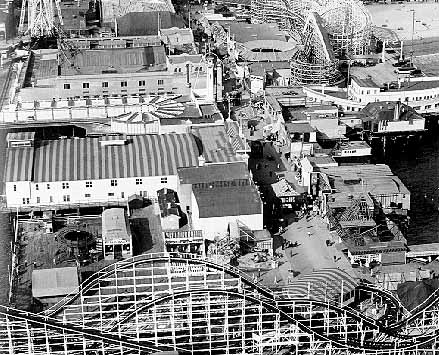
| Aerial view looking inland of the newly built Venice Amusement Pier. It featured three roller coasters, two at the top of the photo and one at the bottom, a fun house, dance hall, and other rides and attractions. - 1923 |
Attractions worth $500,000 were added to the pier for the summer of 1923. Foremost was a $200,000 Fun House that featured 25 different types of rides, slides and freak amusements. Its entrance lobby was a stage where spectators watched woman's dresses shot up by air jets as they weaved through rocking barrels that looked like they would tip over. There were tall steep slides, rotating barrels, spinning turntables, and a mirrored room where you had to find your way out. Children, who could spend their entire afternoon inside for only a nickel, could ride a miniature roller coaster that encircled the structure's rafters.
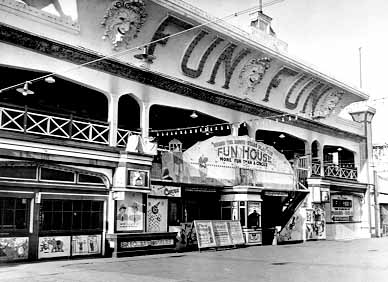
| The Venice Pier Fun House featured slides, a miniature roller coaster, rotating barrels, two spinning wheels, moving stairs, distorted mirrors, and a Mystery Room. Children could play inside all day for only one nickel. - 1923 |
Some Kick, a $60,000 roller coaster occupied the pier's outer end. Others added a Glass House (Mirror Maze), Caterpillar ride, Pig Slide, Baseball Pitcher, Spark Plug and Deep Sea Diving Concessions. A number of children's rides were also added near the end of the pier.
A Coal Mine attraction was added to the pier in September 1924. Burros pulled two passenger carts through a 550 foot long tunnel. Work continued on the huge 65 foot high Flying Circus aerial ride that had been under construction since its foundations were poured in May 1922. When it finally opened in June 1925 (after the builder's April death), passengers in its six eight-passenger planes thought they were actually flying as they circled the high tower. As the ride's six huge vertical arms rose and fell, burst's of compressed air could suddenly spoil the plane's lift and combined with changes in rotation speed, cause the planes to twist into spins and spirals. The last of the attractions that opened that summer was the 98 foot tall Dragon Bamboo Slide. Customers climbed up to the top of the cone shaped tower, then slid down the spiral bamboo ramp on a straw mat.
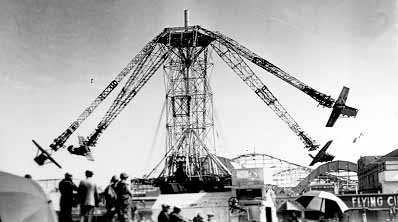
| The Flying Circus was a spectacular aerial ride. Its six, eight passenger planes circled the main tower 65 feet above the pier. - 1925 |
After Venice was annexed to the city of Los Angeles in November 1925, it was affected by Los Angeles' strict "Blue Laws" that both forbid Sunday dancing and gambling games. Business suffered on both the Venice Pier and Lick Piers. Sunday customers instead went to the Ocean Park Pier in nearby Santa Monica. Petitions were circulated around Venice in January 1926 for an ordinance establishing a special amusement zone. The 10,442 valid signatures were more than enough to compel the City Council to call for a special election on April 30th. Fortunately the majority of Los Angeles voters voted for the ordinance; 112,305 for it to 77,832 against. Venice's dance halls reopened for business May 16th.
A few new attractions were added in 1927. Deep sea diver Harry Behrens opened an aquarium on the seaward side of the Dragon Gorge, while others added the Submarine Divers and a wax exhibit called 20 Years in Sing Sing. Now that the Flying Circus ride was loading passengers directly below the tower, its old entrance station and track became part of a ride called the Flying Trains.
Numerous changes were made to the Venice Pier amusement zone in 1928 and 1929. They removed the Bobs roller coaster and put in a flat circular ride called the Hey Dey. The old merry-go-round building next to the Dance Hall was razed for space for a new midway. The Parker carousel from Jones' Fun Palace was moved to the new area and installed under a tent behind Harry Hargrave's Niagara Barrel. Finally a Lindy Loop was placed near the end of the pier.
Venice's amusement park business began to suffer during the first summer of the Depression. There were few improvements made to Venice's amusement zone. A Monkey Zoo opened just beyond the Fun House and a Motordrome was moved to the pier's end. Two new kiddie rides were opened, the Juvenile Circus and the Toyland Riding Academy. Since money was scarce, amusement men resorted to promotions and celebrations rather than new attractions to lure paying customers to their pier.
By 1932 pier business had dropped so substantially that in October the Abbot Kinney Company shocked both investors and concessionaires when they defaulted on bond interest payments. They had sold $350,000 in new bonds only one year earlier to raise capital to retire maturing bonds. The company was placed into receivership and operated by Edward Gerety Jr.
While few people were spending money on amusement rides, they were spending it on Bingo or at least a variation of the popular game. Since Bingo was considered a gambling game and illegal in Los Angeles, clever game operators invented variations that allowed customers to use their "skill" to select numbers. One of the most successful operators was John Harrah and his son John or operated the game in the Plaza Building at the entrance of the pier. His 32 seat parlor grossed $100 the first night it opened in July 1932.
Business improved in 1935 when the Pacific Electric reduced round trip trolley service from downtown Los Angeles. Pier concessionaires also sponsored "Five Cent Days" for children on Wednesday afternoons where kids could ride any one of eight rides for half price. Unfortunately the upturn in business was too late for the owners of the Some Kick roller coaster, for it was razed the previous year.
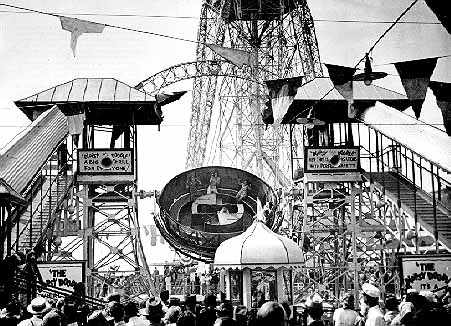
| The Dippsy Doodle ride on the Venice Pier. - 1941 |
When World War II broke out in 1941, pier operations were curtailed at night when it was feared that any stray light might that might become a beacon to enemy warships and submarines. The piers were a favorite for soldiers and sailors who came to Venice and Ocean Park on weekend leaves. Dancing was a favorite place for them to meet local girls and Venice's Dance Hall featured country western bands. By 1943, threats of invasion had diminished to permit near normal operations in the evenings.
When the war ended in 1945, everyone was looking forward to a new prosperity. The Kinney Company was able to take advantage of the availability of building materials to make $60,000 worth of repairs to its deteriorated pier deck.
When the company's 25 year tidelands lease for their pier expired on January 13, 1946, they expected it to be renewed. Besides it was a profitable business with revenues of $100,000 annually and the key to Venice's return to prosperity. However, they were dumbfounded when their landlord, the City of Los Angeles Parks and Recreation Department, refused.
The Parks Department was firm about not renewing the lease because it interfered with their master plan of widening the beach and removing all man made piers. When the area's city councilman made a recommendation that the department postpone the demolition until March 1947, he and the council were rebuked. Parks and Recreation had been adamantly against Venice's honky-tonk atmosphere since the day they annexed the city.
It was a sad day, the end of an era when the pier closed at midnight on Saturday April 20, 1946. While some of the rides were sold to other parks, the buildings, roller coaster, Dragon Slide, even the huge Flying Circus became scrap. While it took more than a year to demolish the pier, an arson fire set by some boys at the Bamboo Slide in May 1947, finished the job.
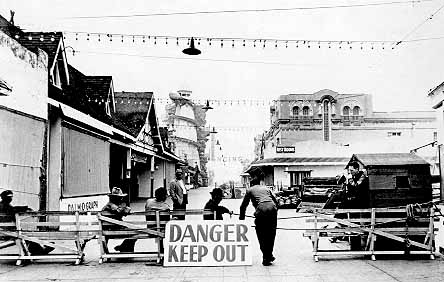
| The Venice Pier closed at midnight April 20, 1946. |